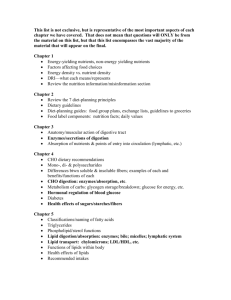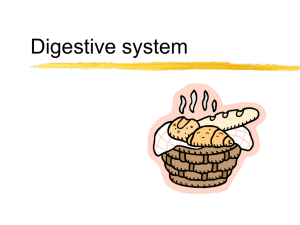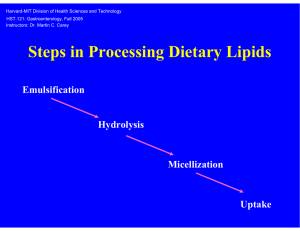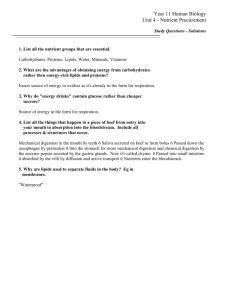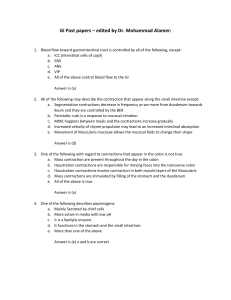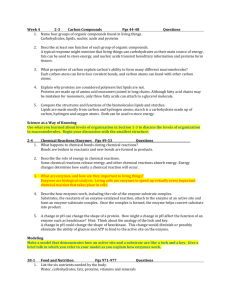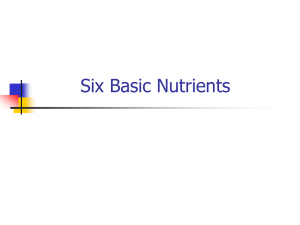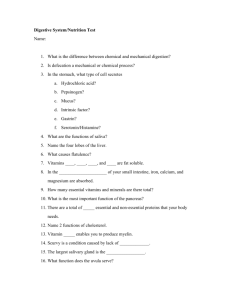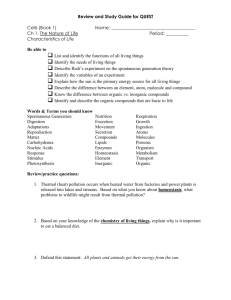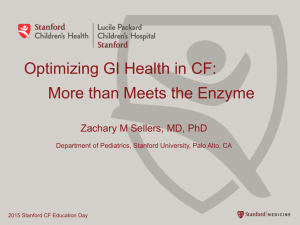proteins
advertisement
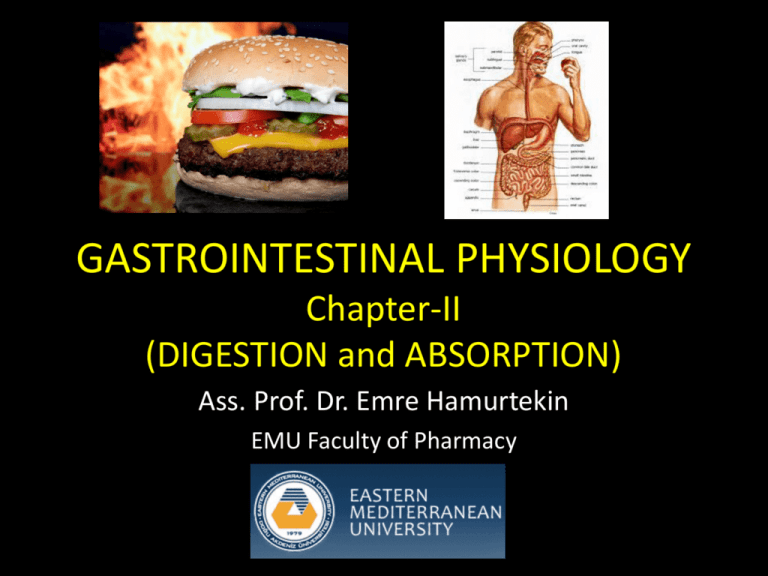
GASTROINTESTINAL PHYSIOLOGY Chapter-II (DIGESTION and ABSORPTION) Ass. Prof. Dr. Emre Hamurtekin EMU Faculty of Pharmacy INTRODUCTION • • • • • CARBOHYDRATES PROTEINS NUCLEIC ACIDS LIPIDS VITAMINS & MINERALS CARBOHYDRATES • The principal dietary carbohydrates are: – Polysaccharides (Starches) • Amylopectin*** • Amylose – Disaccharides (lactose & sucrose) – Monosaccharides (fructose & glucose) • Salivary and pancreatic α-amylases hydrolyze 1:4 α bonds. • The end products of α-amylase digestion are: – – – – Maltose Maltotriose α- limit dextrin Glucose oligomers • Oligosaccharidases are located in the brush border of small intestinal epithelial cells. • Isomaltase is responsible for hydrolysis of 1:6 α bonds CARBOHYDRATES glucose fructose Sucrase Sucrose glucose Lactose Lactase galactose CARBOHYDRATES • SGLT-1 transports glucose & galactose into the intestinal epithelial cell. • Transport of glucose and galactose is dependent on Na in the intestinal lumen. • Fructose absorption is independent of Na; it is transported by facilitated diffusion. • GLUT 5 and GLUT 2 is responsible for the absorption of fructose. PROTEINS • Protein digestion begins in the stomach (pepsins). • Pepsins are secreted as proenzymes and activated by gastric acid. • Pepsinogen I • Pepsinogen II • Products of peptic digestion are polypeptides. PROTEINS • Polypeptides are further digested in the small intestine by pancreatic and intestinal proteolytic enzymes. • Endopeptidases: – Trypsin – Chymotrypsin – Elastase • Exopeptidases: – Carboxypeptidase A – Carboxypeptidase B PROTEINS PROTEINS PROTEINS • Brush border of the intestinal mucosal cell: – Aminopeptidases – Carboxypeptidases – Endopeptidases – Dipeptidases • Intracellular peptidases hydrolyzes some diand tripeptides that enters into the intestinal epithelium. PROTEINS • At least seven different transport systems transport a.a. into enterocytes. • Five of them cotransport a.a. and Na. • Two of them are Na independent. • Di- and tripeptides are transported into enterocytes by PepT1 system (requires H). • A.a absorption is rapid in duodenum and jejunum. NUCLEIC ACIDS Pancreatic nucleases nucleotides Intestinal enzymes nucleosides phosphoric acid blood sugars purine / pyrimidine bases active transport LIPIDS • Most of the fat digestion begins in the duodenum (pancreatic lipase*) • The products are: – FFA – 2-monoglycerides • Pancreatic lipase acts on emulsified fats and activitiy is facilitated by colipase LIPIDS • Steatorrhea: – Fatty, bulky stool because of the impaired digestion and absorption of the fat. – Mostly due to the lipase deficiency, – Gastric acid hypersecretion & defective reabsorption of bile salts are the other causes. – Malabsorption of fat-soluble vitamins results. LIPIDS • Transport of lipids into the enterocytes occurs mainly by passive diffusion, but also carriers may be involved. no modification FA < 10-12 C atoms active transport FFA FA ENTEROCYTE BLOOD esterified FA > 10-12 C atoms Chylomicrons TG + ChE Chylomicrons exocytosis LYMPHATIC CIRCULATION VITAMINS • Fat-soluble vitamins: Vitamin A, D, E and K Most vitamins absorbed Esterase Incorporation into micelles Upper small intestine Vit B12 Absorption Ileum VITAMINS • Vit B12 and folate absorption are Na-independent. • Remaining water-soluble vitamins – – – – – – – Thiamin Riboflavin Niacin Pyridoxine Pantothenate Biotin Ascorbic acid Na cotransporters THE END
